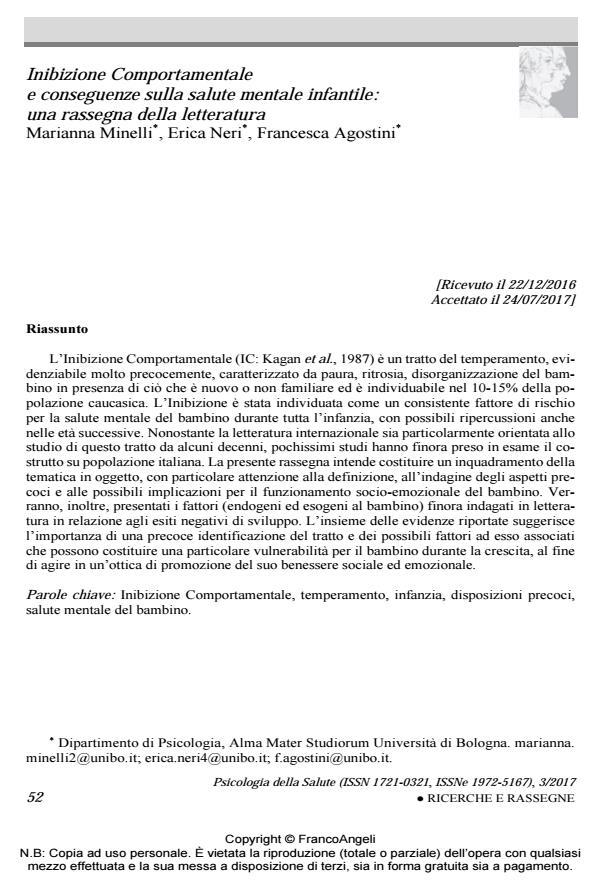Inibizione Comportamentale e conseguenze sulla salute mentale infantile: una rassegna della letteratura
Titolo Rivista PSICOLOGIA DELLA SALUTE
Autori/Curatori Marianna Minelli, Erica Neri, Francesca Agostini
Anno di pubblicazione 2017 Fascicolo 2017/3
Lingua Italiano Numero pagine 22 P. 52-73 Dimensione file 253 KB
DOI 10.3280/PDS2017-003003
Il DOI è il codice a barre della proprietà intellettuale: per saperne di più
clicca qui
Qui sotto puoi vedere in anteprima la prima pagina di questo articolo.
Se questo articolo ti interessa, lo puoi acquistare (e scaricare in formato pdf) seguendo le facili indicazioni per acquistare il download credit. Acquista Download Credits per scaricare questo Articolo in formato PDF

FrancoAngeli è membro della Publishers International Linking Association, Inc (PILA)associazione indipendente e non profit per facilitare (attraverso i servizi tecnologici implementati da CrossRef.org) l’accesso degli studiosi ai contenuti digitali nelle pubblicazioni professionali e scientifiche
L’Inibizione Comportamentale (IC: Kagan et al., 1987) è un tratto del temperamento, evidenziabile molto precocemente, caratterizzato da paura, ritrosia, disorganizzazione del bambino in presenza di ciò che è nuovo o non familiare ed è individuabile nel 10-15% della popolazione caucasica. L’Inibizione è stata individuata come un consistente fattore di rischio per la salute mentale del bambino durante tutta l’infanzia, con possibili ripercussioni anche nelle età successive. Nonostante la letteratura internazionale sia particolarmente orientata allo studio di questo tratto da alcuni decenni, pochissimi studi hanno finora preso in esame il costrutto su popolazione italiana. La presente rassegna intende costituire un inquadramento della tematica in oggetto, con particolare attenzione alla definizione, all’indagine degli aspetti precoci e alle possibili implicazioni per il funzionamento socio-emozionale del bambino. Verranno, inoltre, presentati i fattori (endogeni ed esogeni al bambino) finora indagati in letteratura in relazione agli esiti negativi di sviluppo. L’insieme delle evidenze riportate suggerisce l’importanza di una precoce identificazione del tratto e dei possibili fattori ad esso associati che possono costituire una particolare vulnerabilità per il bambino durante la crescita, al fine di agire in un’ottica di promozione del suo benessere sociale ed emozionale.
Parole chiave:Inibizione Comportamentale, temperamento, infanzia, disposizioni precoci, salute mentale del bambino.
Marianna Minelli, Erica Neri, Francesca Agostini, Inibizione Comportamentale e conseguenze sulla salute mentale infantile: una rassegna della letteratura in "PSICOLOGIA DELLA SALUTE" 3/2017, pp 52-73, DOI: 10.3280/PDS2017-003003